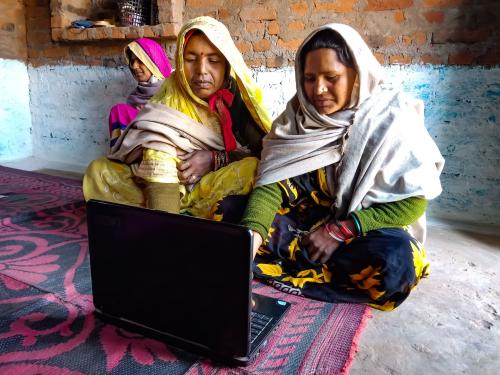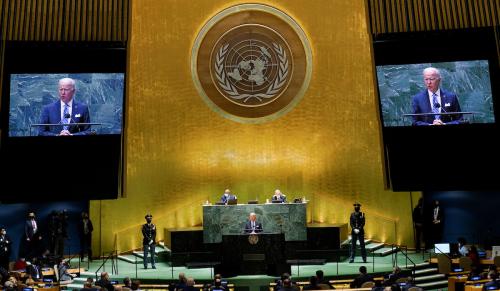On April 18, the Brookings Center for Sustainable Development hosted a roundtable to explore the obstacles facing U.S. government agencies—specifically the U.S. Agency for International Development (USAID)—in the implementation of locally led development. Today we published the background essay that informed the discussion and commentary from 15 of the roundtable participants—representing a diversity of organizations and experiences in global development—as well as a proposed narrative with principles and values.
The title, “Locally driven development: Overcoming the obstacles,” accurately describes the subject of the essay. It briefly presents the ways in which each of the past four U.S. administrations have moved development policies and programs onto a more locally led path so that stakeholders in developing countries have greater agency. It then details six major impediments to the U.S. implementing locally led development. In brief:
- Capacity: Many organizations in developing countries lack the technical capacity to fulfill USAID accountability requirements and manage sizeable projects. USAID lacks sufficient staff quantity and with the relevant training to oversee large numbers of small grants and contracts and base programming on local priorities.
- Risks: Accompanying the benefits of engaging with local organizations steeped in the local culture and connections are possible heightened financial, programmatic, and fiduciary risks of working with small, technically less experienced organizations.
- Rigidity: USAID’s ability to be responsive and adaptive to local priorities and needs is constrained by rigidities flowing from: the lengthy, complex U.S. budgetary process; presidential initiatives and earmarks/directives in appropriations bills; USAID management best practices such as strategies and accountability measures; and insufficient delegation of authority to USAID country missions.
- Organizational culture: Localization asks USAID’s highly skilled and committed development experts to take a less assertive role in deference to local priorities, experience, and knowledge.
- Values: The U.S. will not forgo fundamental American and international values (e.g., rule of law, individual and human rights, inclusion, and gender equality).
- Power dynamics: It is a challenge to shift decisionmaking power from donor to beneficiary.
The essay makes a series of recommendations on how to address these obstacles. They range from building up and training USAID staff, to helping U.S. stakeholders understand that localization involves accepting greater risk, to providing USAID with greater authority to manage budgets and programs.
It also highlights several overarching challenges in advancing localization and the flexibility it requires. One challenge is that—to cede power—stakeholders would have to recognize that what is in the ultimate interest of the United States is not control of specific development activities but developing country partners having long-term stability and prosperity; this follows the model of placing decisionmaking in the hands of those closest to the action and of “leader as servant.”
A second challenge is that in pursuing a medium-/long-term strategy of transitioning programs to local ownership, USAID would need to adopt a short-/medium-term strategy of challenging its traditional implementers to operate in that mode.
Commentary
Accompanying the essay are 15 commentaries by participants at the roundtable. The objective of the commentaries is to build on and share the richness of the discussion at the roundtable and present the range of issues and perspectives on a topic as complex as locally led development—something a single author is unable to do. The commentaries range from providing a different perspective or nuance on aspects of the essay, drilling down on a topic, and introducing a new issue.
Several of the commentaries note the need for greater clarity on what is meant by locally led development and the need for metrics to measure progress. I likely subconsciously avoided the matter of metrics from a concern that metrics often do not accurately reflect reality and become the driver of a project in place of the development objective—as several of the commentaries note—but I concur that relevant metrics are important to track and assess progress.
Another action I failed to note in the essay but that I have referenced in the past is several authors’ suggestion that a way to act on localization is for USAID to return to the past practice of issuing more grants, which, unlike cooperative agreements and contracts, require less USAID staff involvement.
Several other commentaries bring in other issues not covered by the essay—the need for mutual accountability, the importance of domestic resource mobilization, and the role of the Grand Bargain in bringing localization to humanitarian assistance.
Various commentaries focus on the role of local partners. One points out that local entities must be treated as true partners—not just delivery mechanisms; another notes the importance of building local capacity; and yet another asserts that directing funding to local partners is a step toward local empowerment. Several authors emphasize the importance of feedback loops in shifting the balance of power. Another makes a strong argument that the focus should be on building and supporting community leadership. Several people drilled down on the importance of giving greater voice to local actors, and one notes that, with the increase in recent years in earmarks and directives, the local voice in U.S. development activities has weakened.
The importance of success stories is noted by two authors—one suggesting that USAID issue a “case study challenge” to implementers to benefit from both past successes and failures. Several commentaries emphasize that procurement is at the heart of implementing localization, noting the impediments created by the Federal Acquisition Regulations, that compliance can undermine effectiveness, and that other U.S. government agencies have found simpler ways to comply with federal regulations.
One commentary gives an interesting explanation of how the core issue in localization is not “effectiveness,” but rather “sustainability.” On the one hand, I agree with the point—sustainability is the goal; on the other, maybe sustainability is part of one’s definition of effectiveness. This demonstrates the value of the commentaries in providing more than one person’s perspective and experience.
Narrative
The essay concludes by proposing a brief narrative to convince U.S. stakeholders of the central importance of localization and the flexibility required to implement it:
- Economic, social, and political progress in low-income and lower-middle income countries is in the U.S. national interest.
- Economic assistance can contribute to this objective only if used effectively.
- Seventy-five years of development experience corroborates that effectiveness is grounded in local partners setting priorities and implementing programs.
- This locally led development requires that assistance be managed flexibly so as to adapt to country priorities and changing circumstances.
- The most effective role for the U.S. is to (1) lead on values and basic principles and (2) support partner country priorities in how they adapt those values and principles to fit their own circumstances
It is this leading with values and supporting local priorities approach that will inspire other development actors, earn the U.S. respect as a valued development partner, and distinguish the U.S. from more autocratic approaches.
I invite readers to submit comments and reactions to this proposed narrative.







Commentary
Obstacles and recommendations for moving US development policies onto a locally led path
May 9, 2022